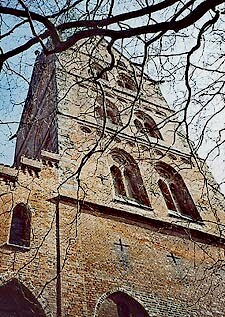Aegidienkirche, Lübeck on:
[Wikipedia]
[Google]
[Amazon]
 The St.-Aegidien-Kirche or Aegidienkirche is a church building in the north German city of
The St.-Aegidien-Kirche or Aegidienkirche is a church building in the north German city of
Parish website
Bachchor Lübeck
{{Coord, 53.8639, N, 10.6898, E, source:wikidata, display=title, format=dms
 The St.-Aegidien-Kirche or Aegidienkirche is a church building in the north German city of
The St.-Aegidien-Kirche or Aegidienkirche is a church building in the north German city of Lübeck
Lübeck (; or ; Latin: ), officially the Hanseatic League, Hanseatic City of Lübeck (), is a city in Northern Germany. With around 220,000 inhabitants, it is the second-largest city on the German Baltic Sea, Baltic coast and the second-larg ...
, dedicated to saint Giles
Saint Giles (, , , , ; 650 - 710), also known as Giles the Hermit, was a hermit or monk active in the lower Rhône most likely in the 7th century. Revered as a saint, his cult became widely diffused but his hagiography is mostly legendary. A ...
. It is the smallest and easternmost church in the city centre. It is first mentioned as dedicated to St Giles in 1227; this is unusual for a north German and may link it to an earlier 1172–1182 wooden church built under bishop Henry I, formerly the abbot of the abbey dedicated to the same saint in Braunschweig
Braunschweig () or Brunswick ( ; from Low German , local dialect: ) is a List of cities and towns in Germany, city in Lower Saxony, Germany, north of the Harz Mountains at the farthest navigable point of the river Oker, which connects it to the ...
. The church's coat of arms includes a "T", short for "Tilgenkark", the Low German
Low German is a West Germanic languages, West Germanic language variety, language spoken mainly in Northern Germany and the northeastern Netherlands. The dialect of Plautdietsch is also spoken in the Russian Mennonite diaspora worldwide. "Low" ...
form of the church's name, and "St Tilgen" or "St. Illigen", the Low German forms of the saint's name.
It remained in the nearby cathedral chapter's control until the Protestant Reformation
The Reformation, also known as the Protestant Reformation or the European Reformation, was a time of major theological movement in Western Christianity in 16th-century Europe that posed a religious and political challenge to the papacy and ...
, when shortly after Easter 1530 it hosted the town's first eucharist in which both elements were distributed to the people. Its pastor "Johann by der Erde" was also the city's first clergyman to marry, also in 1530. The church roof was hit by a shell during the 1806 Battle of Lübeck
The Battle of Lübeck took place on 6 November 1806 in Lübeck, Germany between soldiers of the Kingdom of Prussia led by Gebhard Leberecht von Blücher, who were retreating from defeat at the Battle of Jena–Auerstedt, and troops of the Fir ...
but it did not ignite, whilst a cannonball from the same engagement is still lodged in the wall near the north door. The area around the church was heavily damaged during the March 1942 air-raid on the city and an aerial mine
A naval mine is a self-contained explosive weapon placed in water to damage or destroy surface ships or submarines. Similar to anti-personnel and other land mines, and unlike purpose launched naval depth charges, they are deposited and left to ...
destroyed historic stained-glass and work by Curt Stoermer
Curt Stoermer (born Kurt Karl August Störmer, 26 April 189129 January 1976) was a German painter, a representative of the Worpswede branch of expressionist art.
Biography
Born in Hagen in 1891, Stoermer was influenced in his youth by the opening ...
inside the church but left the exterior unaffected.
External links
Parish website
Bachchor Lübeck
{{Coord, 53.8639, N, 10.6898, E, source:wikidata, display=title, format=dms
References
Lutheran churches in Schleswig-Holstein Churches in Lübeck Brick Gothic Gothic architecture in Germany 12th-century churches in Germany